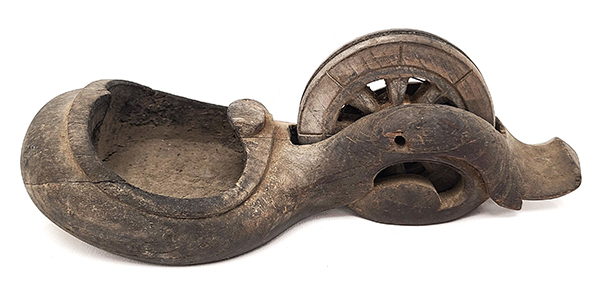Japanese Carpentry Tool

This traditional Japanese tool is known as a sumitsubo. In English, the name translates to ink pot, but it is also referred to as an ink line or ink line reel. It is used to mark lines on wood, similar to chalk lines often used in the US, but it creates a much finer and darker line.
A sumitsubo features a thin line of thread, often silk, spooled around a reel. The thread passes through the inkwell portion of the tool, which is filled with silk or cotton fibers soaked in ink. As the line is pulled, the thread soaks up ink from the well. The far end of the line is attached to a wooden piece with a sharp pin, called a karuko, which the carpenter pushes into the wood to secure the end in place. This piece is missing from our example. The carpenter then reels out the inked line over the surface, picks it up and lets it snap into place, leaving the ink mark on the wood. Using this tool, perfectly straight lines can be marked over long distances. Traditional Japanese carpentry often relies on joining pieces of wood without nails or screws, which makes the precise measurements and straight lines created by the tool especially important.
The sumitsubo is often the most elaborate tool in a Japanese carpenter’s otherwise modest toolbox, and because it is used for the first step in a carpentry project, it has a special significance. It even symbolizes the carpentry profession in Japan. The sumitsubo was traditionally made by the individual using it, and it served as an opportunity to display his craftsmanship and artistic skills, resulting in some tools with very elaborate carvings. This example is relatively plain in design, but nonetheless took skill to create. Tools like the sumitsubo reflect the Japanese idea of monozukuri, the art of making things, in which the process is equally important as the final creation.
This sumitsubo is from the early 20th century. Typical of Western Japan, it does not have a crank for the reel. Sumitsubo date back as far as the 8th century in various forms, and they are still used today, both in the form seen here and as a more compact plastic tool.
Watch a Japanese carpenter use a traditional sumitsubo:
Other objects from Japan that have been featured for Artifact of the Month include Hanafuda cards, carp streamers, Kokeshi dolls, and a belt ornament.
